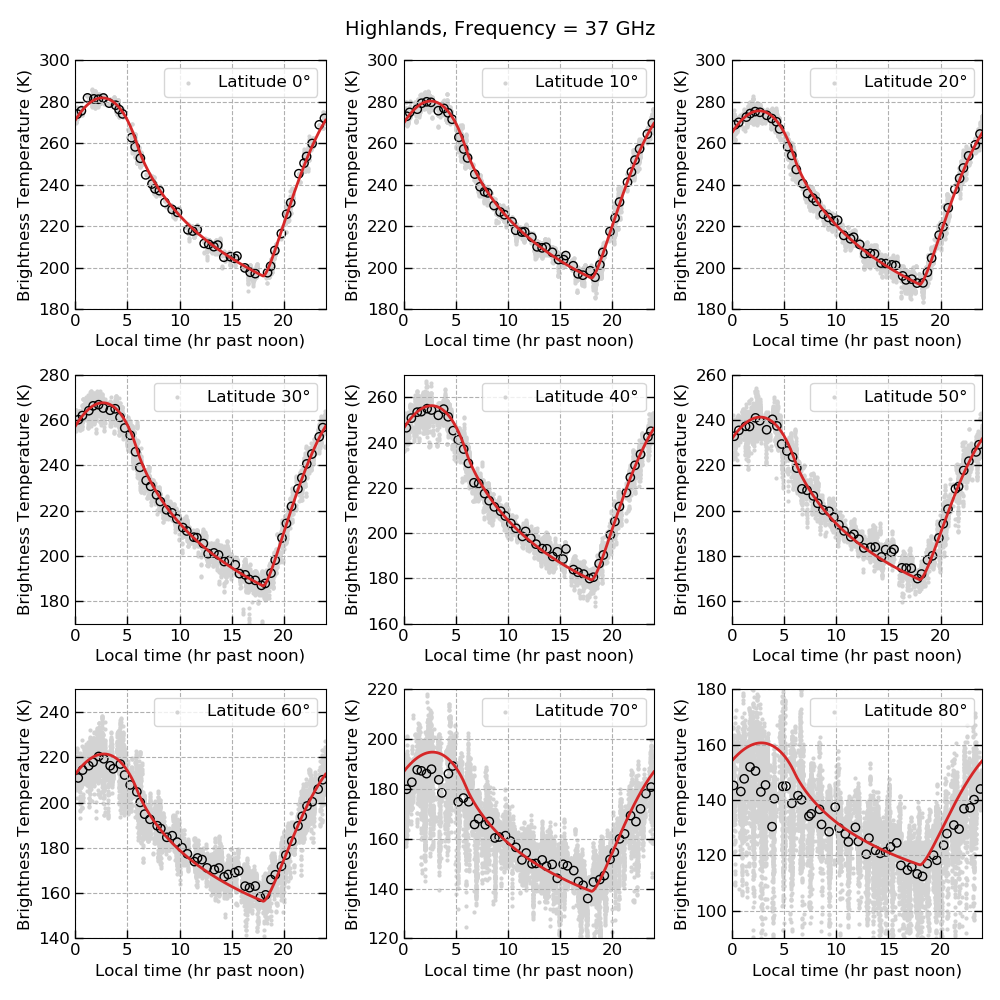Lunar regolith properties derived from Chang’E-2/MRM data: What can the microwave tell us?
- 1Institute of Geophysics and Extraterrestrial Physics, TU Braunschweig, Braunschweig, Germany (j.buerger@tu-bs.de)
- 2Planetary Science Institute, Tuson, AZ, United States
- 3Hawai'i Institute of Geophysics and Planetology, University of Hawai'i at Mānoa, Honolulu, HI, United States
Radiometric measurements of the (sub-)surface thermal emission allow determination of the microphysical structure (e.g. porosity and particle size) and thermophysical properties of the regolith. In our previous study (Bürger et al., 2024), we derived regolith grain size and regolith stratification from LRO/Diviner data (Paige et al., 2010) and a microphysical thermal model, but the derived parameter sets were non-unique. While radiometric observations in the infrared (e.g., LRO/Diviner) are sensitive to surface temperatures, microwave radiometric measurements are also sensitive to the thermal emission from the subsurface. Therefore, we will investigate whether the microwave data can be used to apply constraints on the sub-surface regolith properties (grain size, stratification) and the non-unique parameter sets derived in Bürger et al. (2024).
The microwave radiometer (MRM) on board the Chang'E-2 mission measured the brightness temperature of the lunar surface in four different frequency channels: 3, 7.8, 19.35 and 37 GHz (Feng et al., 2013; Zheng et al., 2019). It was in operation from October 2010 to May 2011 and the resolution of the instrument on the lunar surface was about two pixels per degree.
We filtered the Chang’E-2/MRM data to achieve the best quality by selecting only those pixels with low rock abundance, small local slope angle and within a narrow range of albedo values. The albedo filter also allowed us to separate measurements in the highlands and in the maria, as each has a characteristic difference in albedo. The measurements obtained in the maria were additionally filtered according to their TiO2 abundance, which has a pronounced influence on the optical properties of the regolith (Feng et al., 2020; Siegler et al., 2020; Sohn et al., 1994). The filtered data are sampled for every latitude in steps of 1° and the data points in the northern and southern hemisphere are combined under the assumption that the regolith properties are the same in both hemispheres. Figure 1 shows the filtered CE-2/MRM brightness temperatures measured at 37 GHz together with their mean values as a function of latitude for the highlands.
For the interpretation of the microwave measurements, a radiative transfer model is required in addition to a thermal model to generate synthetic brightness temperatures. In this project, we apply the radiative transfer model presented in Feng et al. (2020) and Siegler et al. (2020). First, physical temperatures in each layer are modelled using the microphysical thermal model introduced in Bürger et al. (2024), which describes the regolith in terms of grain size and volume filling factor. Second, a synthetic brightness temperature is obtained by multiplying the simulated physical temperature of each regolith layer with a weighting factor that depends on the frequency of the measurement and the relative dielectric constant, the loss tangent and the bulk density of the regolith layer, and then taking the sum of all weighted temperatures.
At the conference we will present and discuss the regolith properties derived from the CE-2/MRM data. In more detail, we will investigate the regolith properties for maria and highlands separately and revisit the latitudinal dependence of regolith properties. In Bürger et al. (2024) we found a latitudinal gradient between LRO/Diviner data and the microphysical thermal model, which could be reduced by a variation of the albedo as a function of solar incidence angle or a decrease in bulk density with increasing latitude. Figure 1 illustrates an initial comparison between model and Chang’E-2/MRM measurements and shows that, in contrast, the nighttime microwave data do not exhibit a pronounced latitudinal gradient. However, during the day and at the highest latitudes daytime shadowing effects are present. The brightness temperatures were modeled assuming constant regolith properties derived from a fit at 0° latitude and no albedo or bulk density variation with latitude was applied. These findings will be further investigated and discussed.

Figure 1: Filtered Chang’E-2/MRM measurements obtained at a frequency of 37 GHz as a function of local time and their corresponding mean values (black circles) for highlands. The measurements are collected in latitude bins with a bin size of 1°. The red solid line represents the modeled brightness temperature assuming constant regolith properties derived from a fit at 0° latitude for all latitudes.
References
Bürger, J. et al. (2024), JGR, 129(3). Feng, J. et al. (2020), JGR, 125(1). Paige et al. (2010), Space Sci. Rev., 150(1–4), 125–160. Siegler, M. A. et al. (2020), JGR, 125(9). Sohn et al. (1994), Jpn. J. Appl. Phys., 33, 5466-5470. Zheng et al. (2019), Icarus, 319, 627-644.
How to cite: Buerger, J., Feng, J., Siegler, M., and Blum, J.: Lunar regolith properties derived from Chang’E-2/MRM data: What can the microwave tell us?, Europlanet Science Congress 2024, Berlin, Germany, 8–13 Sep 2024, EPSC2024-83, https://doi.org/10.5194/epsc2024-83, 2024.